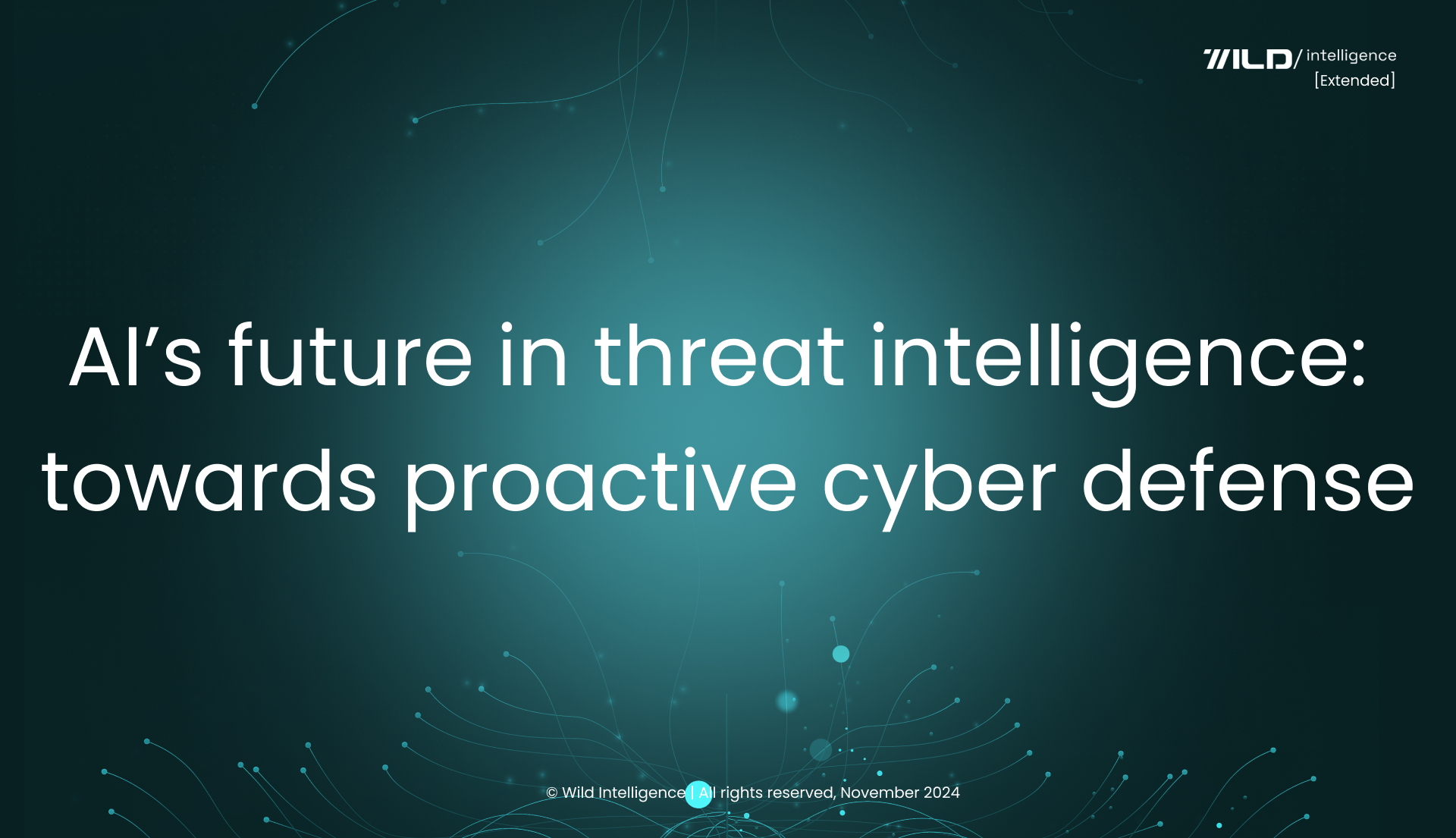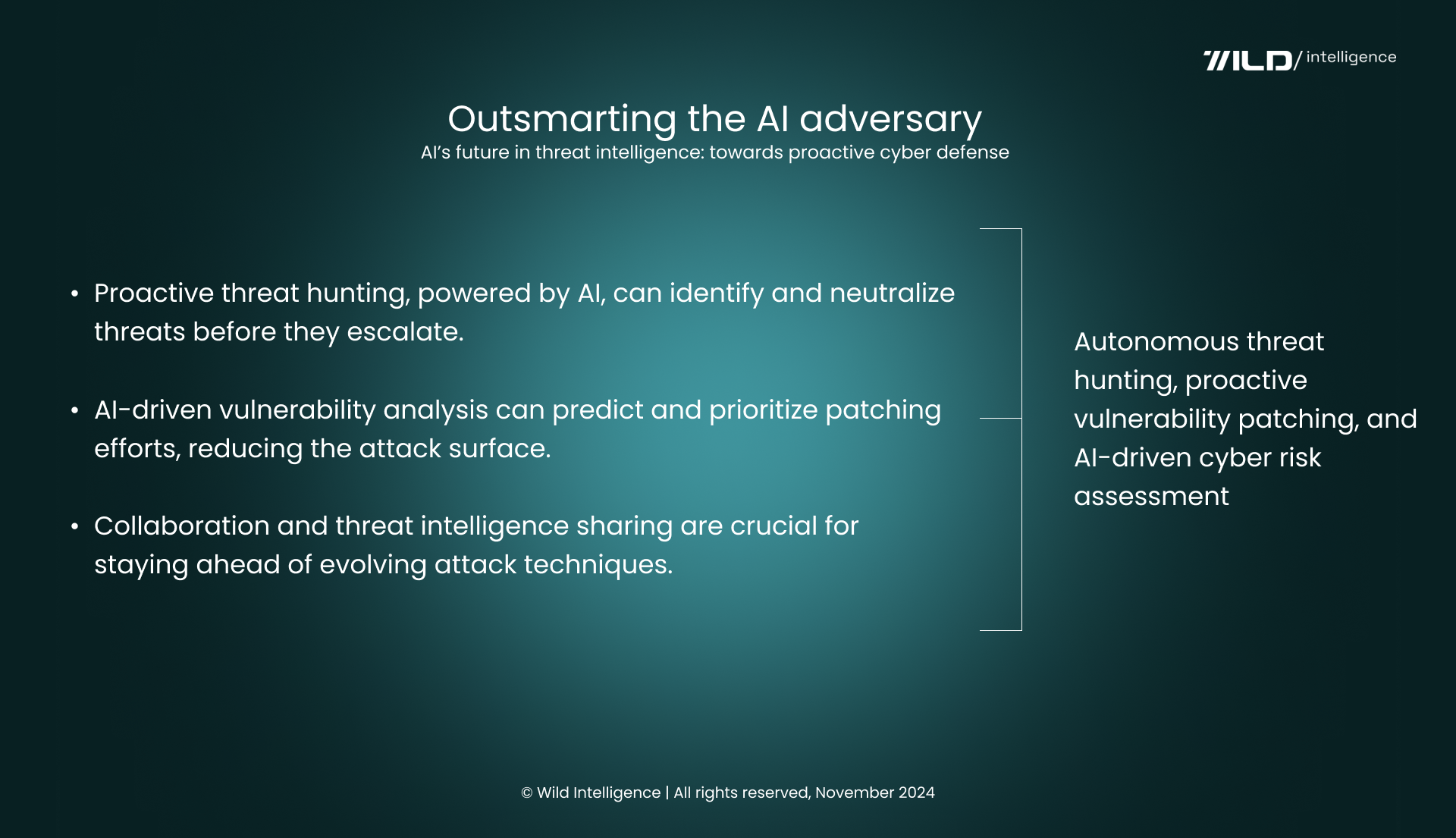AI’s future in threat intelligence: towards proactive cyber defense
Hello,
Imagine a world where cyberattacks are anticipated and neutralized before they even strike.
A world where vulnerabilities are patched before they can be exploited, and cyber threats are identified and mitigated before they can cause harm.
This is the promise of proactive cyber defense, a future where AI takes center stage in the ongoing battle against cybercrime.
AI is poised to revolutionize threat intelligence, enabling a paradigm shift from reactive to proactive security.
Imagine autonomous systems that hunt for threats lurking in the shadows, predict vulnerabilities before malicious actors discover them, and assess cyber risks with unprecedented accuracy.
This is not science fiction; the future awaits us, where AI empowers organizations to stay ahead of the curve and build truly resilient cyber defenses.
But the question remains: How can we unlock this future and harness AI's full potential for proactive cyber defense?
The AI arms race: a proactive defense in the age of Intelligent threats
On the one side (offense), the evolving attacker
Cybercriminals are no longer just script kiddies armed with essential tools.
They are increasingly sophisticated, leveraging AI to automate attacks, evade detection, and exploit vulnerabilities with unprecedented precision.
AI-powered malware can morph and adapt to security measures, rendering traditional defenses obsolete.
Deepfakes can spread disinformation and manipulate public opinion, while AI-driven social engineering attacks can bypass even the most vigilant human defenses.
The offensive capabilities of AI are growing at an alarming rate, posing a significant challenge to defenders worldwide.
On the other side (defense), the proactive defender
But the defenders are not standing still.
AI is also being harnessed for good, empowering organizations to anticipate and mitigate future threats.
AI-powered threat intelligence platforms can analyze vast datasets, identify patterns, and predict emerging threats.
AI-driven vulnerability analysis can proactively identify weaknesses and prioritize patching efforts.
And AI-powered deception technologies can lure attackers into honeypots, providing valuable insights into their tactics and techniques.
The proactive defender embraces AI to stay ahead of the curve, building a more resilient and adaptive security posture.
The things to know:
This is an arms race where the stakes are high.
The future of cybersecurity hinges on the ability of defenders to outpace attackers in the AI domain.
This requires a multi-faceted approach:
Investing in AI research and development:
Support the development of new AI-powered security tools and techniques.
Foster collaboration between academia, industry, and government to accelerate innovation.Building a skilled workforce:
Train and equip security professionals with the knowledge and skills to leverage AI effectively.
Foster a culture of continuous learning and adaptation.Promoting ethical AI development:
Ensure that AI is developed and used responsibly, ethically, and transparently. Mitigate bias, promote fairness, and protect privacy.International collaboration:
Foster international cooperation and information sharing to combat the global threat of AI-powered cyberattacks.
The future of AI in threat intelligence: towards proactive cyber defense, the takeaway:
The battleground is set. Those who can effectively harness AI's power for proactive defense will define the future of cybersecurity.
We can build a more secure and resilient digital world by embracing innovation, fostering collaboration, and prioritizing ethical considerations.
Technical deep dive: emerging technologies for proactive cyber defense
Privacy-preserving techniques like differential privacy and federated learning can help mitigate risks.
Differential privacy adds noise to datasets to protect individual identities while preserving overall patterns.
Federated learning allows AI models to be trained on decentralized data sources, reducing the need to share sensitive information.
Threat intelligence sharing platforms:
These platforms facilitate collaboration and information exchange among organizations, enabling them to defend against cyber threats collectively.
By sharing threat data, organizations can gain a broader understanding of the threat landscape, quickly identify emerging threats, and develop more effective countermeasures.
Examples include platforms like MISP (Malware Information Sharing Platform) and VirusTotal.
Blockchain for secure data exchange:
Blockchain technology can enhance the security and integrity of threat intelligence data.
By storing threat data on a decentralized and immutable ledger, blockchain can ensure the data is tamper-proof and trustworthy. This can help prevent data manipulation and guarantee the authenticity of threat intelligence.
AI-powered deception technologies:
Deception technologies create decoys and traps to lure attackers away from critical assets and gather intelligence on their tactics and techniques.
AI can enhance deception technologies by automating the creation and deployment of decoys, analyzing attacker behavior, and adapting deception strategies in real-time. Examples include honeypots, honey files, and decoy credentials.
Coding methodologies and standards for adaptive AI
Continuous learning:
AI models for threat intelligence must be capable of continuous learning and adaptation to stay ahead of evolving threats.
This can be achieved through techniques like online learning, where models are continuously updated with new data, and reinforcement learning, where models learn through trial and error.
Adaptability:
AI systems should be designed to adapt to changing threat landscapes and new attack techniques.
This can involve using modular architectures that allow easy updates and continuously incorporating feedback loops to improve model performance.
Explainability:
Explainable AI (XAI) techniques should be employed to understand how AI models make decisions and identify potential biases or errors.
This can help ensure that AI systems are transparent and accountable.
AI lifecycle stage: continuous improvement and evolution
Monitoring and evaluation:
AI models for threat intelligence should be continuously monitored and evaluated to ensure their accuracy, effectiveness, and ethical alignment.
This involves tracking key performance indicators (KPIs), conducting regular audits, and incorporating feedback from human analysts.
Retraining and updating:
Models should be retrained and updated regularly with new data to adapt to evolving threats and maintain their effectiveness.
This can involve using techniques like transfer learning, where knowledge from pre-trained models is transferred to new models, and active learning, where models actively seek out new data to improve their performance.
Version control and rollback:
Implement version control for AI models to track changes and allow for rollback to previous versions if necessary.
This can help ensure stability and prevent unintended consequences from model updates.
Case study: MITRE ATT&CK framework and AI
The MITRE ATT&CK framework provides a knowledge base of adversary tactics and techniques. Integrating AI with ATT&CK allows for proactive threat hunting, identifying potential attacks based on observed behaviors and patterns.
This approach enables organizations to anticipate and mitigate threats before they can cause damage.
Insights:
Proactive threat hunting, powered by AI, can identify and neutralize threats before they escalate.
AI-driven vulnerability analysis can predict and prioritize patching efforts, reducing the attack surface.
Collaboration and threat intelligence sharing are crucial for staying ahead of evolving attack techniques.
Relevant uses:
Autonomous threat hunting, proactive vulnerability patching, and AI-driven cyber risk assessment.
Related study reference:
Cybersecurity and Artificial Intelligence: Challenges and Opportunities" by World Economic Forum.
Conclusion
Decision leaders must invest in the future of AI-powered threat intelligence, embrace proactive defense strategies, and foster a culture of innovation and collaboration.
This will enable organizations to stay ahead of the curve and build a more resilient cybersecurity posture.
By embracing emerging technologies and prioritizing continuous learning, organizations can harness AI's power to defend against cyber threats and safeguard their critical assets proactively.
Our recommendations:
But how can we unlock this future and harness AI's full potential for proactive cyber defense? The answer lies in a strategic and multifaceted approach.
Embrace emerging technologies:
AI-powered threat hunting: Invest in AI-powered tools that can autonomously search for and neutralize threats before they escalate.
Predictive vulnerability management: Utilize AI to predict and prioritize patching efforts, reducing the attack surface and strengthening defenses.
Threat intelligence sharing: Foster collaboration and information sharing among organizations and security communities to stay ahead of evolving attack techniques.
Foster a culture of innovation:
Research and development: Invest in research and development to explore new AI-powered security solutions and techniques.
Continuous learning: Encourage continuous learning and skill development among security professionals to keep pace with the evolving threat landscape.
Agile adaptation: Foster an agile and adaptive security culture that can quickly respond to new threats and challenges.
Prioritize ethical considerations:
Transparency and explainability: Ensure that AI systems are transparent and explainable, allowing for human understanding and accountability.
Bias mitigation: Implement measures to identify and mitigate bias in AI models, ensuring fairness and preventing discriminatory outcomes.
Human oversight: Maintain human oversight and intervention in AI-powered security systems to ensure responsible and ethical use.
By embracing these principles and fostering a proactive AI safety mindset, organizations can unlock AI's full potential for cyber defense and build a more secure and resilient future.


